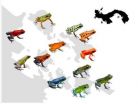(Press-News.org) The toothiest prehistoric predators also had beefier arm bones, according to results of a study published today in the journal Paleobiology.
Saber-toothed tigers may come to mind, but these extinct cats weren't the only animals with fearsome fangs.
Take the false saber-toothed cats--also known as nimravids--and their catlike cousins, a family of carnivores called the barbourofelids.
These mammal groups lived millions of years before cats came to be, and had knife-like canines along with well-built arm bones, said Julie Meachen, a paleontologist at the National Science Foundation (NSF) National Evolutionary Synthesis Center (NESCent) in Durham, North Carolina.
This killer combination arose repeatedly in different saber-toothed predators over time, presumably because it gave them an advantage when catching and killing prey, Meachen found.
"This is a nice demonstration that selection usually operates on suites of traits to generate solutions to environmental challenges," said Saran Twombly, program director in NSF's Directorate for Biological Sciences, which funds NESCent.
"In this case, the key to being an efficient predator integrated canines and forelimbs across different groups of felids and led to the development of different combinations of these traits," said Twombly. "It was the combination, rather than any single trait, that allowed a diverse group of organisms to thrive as predators."
The long, thin teeth of saber-toothed cats look formidable, but they're fragile compared with those of felines today.
"Cats now have canines that are short and round in cross-section, so they can withstand forces in all directions," Meachen said.
"That comes in handy for hunting--their teeth are better able to withstand the stress and strain of struggling prey without breaking."
In contrast, the elongated canines of saber-toothed cats were flattened side-to-side and were more oval, which made them more vulnerable to fracture.
In previous results published in 2010, Meachen reported that the saber-toothed cat Smilodon fatalis had exceptionally thick arm bones when compared with its feline cousins.
"Thick, robust bones are an indicator of forelimb strength," Meachen said.
The results suggest that these animals may have relied on their forelimbs to help catch and kill their prey without fracturing their fangs.
In studying the fossil skeletons of other saber-toothed predators, Meachen had a hunch that the combination of fragile knife-like canines and beefy arm bones might not have been unique to saber-toothed cats.
Earth was once home to a number of toothy carnivores that no longer roam the wilds.
Nimravids were meat-eaters that flourished for almost 35 million years, from about 42 to 7 million years ago, alongside another group of extinct predators, the barbourofelids, which lived from 17 to 9 million years ago, when they died out.
"If you saw one of these animals you'd probably think it was a cat, but true cats didn't evolve until millions of years later," Meachen said.
The animals left no living descendants, but thanks to fossilized bones scientists know that their upper canines came in a wide range of shapes and sizes.
Some species had canines that were short and round; others were long, flattened and more oval. Some were serrated "like a steak knife," Meachen said.
To find out if saber-toothed predators with longer, thinner teeth and delicate dentition generally had thicker forelimbs, Meachen measured the fossilized arm bones and upper canines of hundreds of museum specimens of extinct cats, nimravids and barbourofelids that once roamed North America.
She also measured the teeth and arm bones of 13 cat species living today--such as the tiger and the clouded leopard--all of which have conical teeth.
When she compared the dimensions of the teeth to those of the arms, she found that each group of animals gradually converged on the same solution--the longer the teeth, the thicker the forelimbs.
The results held up even after taking into account that larger species generally have bigger bones.
She attributes the striking similarities among the species to convergent evolution.
"The same correlated sets of traits arose repeatedly through time," Meachen said.
"It's hard to know which came first--long, fragile canines, or strong, robust forelimbs. It's sort of a chicken-and-egg question."
INFORMATION:
Prehistoric predators with supersized teeth had beefier arm bones
Combination of colossal canines and forceful forelimbs arose repeatedly over time
2012-01-05
ELSE PRESS RELEASES FROM THIS DATE:
Hamilton Dentist Performs All Dental Work Including Cleanings for Patients
2012-01-05
Patients can rely on Dr. Scot Rosen, Hamilton dentist, for the completion of all of their dental health care needs. Dr. Rosen prides himself in completing all services and procedures to meet his patients' dental health care needs, including dental cleanings.
"It is important that my patients receive superior dental care, and it is my honor to be able to complete all of their needed dental work myself. From routine cleanings to more complex procedures, I pride myself in performing them all," said Dr. Scot Rosen, dentist in Trenton.
By performing available ...
Monaco Retains Title as the World's Most Prestigious Property Address
2012-01-05
Despite the depressing headlines throughout the world's press of late, property for sale in Monaco and the French Riviera is faring particularly well compared to many of its European neighbours.
Recent research has proven that despite restrictive measures enforced by most governments, Europe is still leading the field in the sale of exclusive real estate to wealthy investors. Indeed, Sotheby's auction house has revealed that sales in luxury property in Monaco and France has risen by 38% this last quarter compared to the previous quarter.
Those looking to purchase ...
Fish mimics octopus that mimics fish
2012-01-05
SAN FRANCISCO (January 4, 2012) — Nature's game of intimidation and imitation comes full circle in the waters of Indonesia, where scientists have recorded for the first time an association between the black-marble jawfish (Stalix cf. histrio) and the mimic octopus (Thaumoctopus mimicus).
Undescribed by scientists until 1998, the talented mimic octopus is known to impersonate toxic flatfish, lionfish, and even sea snakes by creatively configuring its limbs, adopting characteristic undulating movements, and displaying bold brown-and-white color patterns. Thanks to these ...
No more free rides for 'piggy-backing' viruses
2012-01-05
Scientists have determined the structure of the enzyme endomannosidase, significantly advancing our understanding of how a group of devastating human viruses including HIV and Hepatitis C hijack human enzymes to reproduce and cause disease.
The findings open the door to the development of new drugs to combat these deadly viruses that infect more than 180 million people worldwide.
The team of international scientists led by and Professor Gideon Davies from the University of York and Associate Professor Spencer Williams from the University of Melbourne, studied bacterial ...
Russian river water unexpected culprit behind Arctic freshening near US, Canada
2012-01-05
A hemispherewide phenomenon – and not just regional forces – has caused record-breaking amounts of freshwater to accumulate in the Arctic's Beaufort Sea.
Frigid freshwater flowing into the Arctic Ocean from three of Russia's mighty rivers was diverted hundreds of miles to a completely different part of the ocean in response to a decades-long shift in atmospheric pressure associated with the phenomenon called the Arctic Oscillation, according to findings published in the Jan. 5 issue of Nature.
The new findings show that a low pressure pattern created by the Arctic Oscillation ...
One in Four Brits Spend 40% of Take-Home Pay on Debt Payments, Reveals Debt Solutions Company, Debt Relief Orders
2012-01-05
The report from Moneysupermarket.com revealed that the average amount of non-mortgage debt paid off each month is GBP322 a month, around 25% of the average monthly net salary for a UK adult, while a shocking 8% claim to have spent over 80% of their wages repaying debt. And despite women having the reputation for being prolific shoppers, it is men that appear to have 15% more personal unsecured debt compared to their female counterparts - on average GBP7,944 compared to GBP6,739.
MoneySupermarket.com's head of loans and debt, Tim Moss, said: "With the cost of living ...
New fermented soy ingredient containing S-equol significantly reduced hot flash frequency
2012-01-05
Northridge, CALIF (Jan 4, 2012) – Daily doses of a soy germ-based nutritional supplement containing S-equol significantly improved menopausal symptoms, including significantly reducing hot flash frequency after 12 weeks according to a placebo-controlled study in postmenopausal Japanese women published in the peer-reviewed Journal of Women's Health.
"It is believed that S-equol, produced from the isoflavone daidzein during the fermentation of soy germ, interacts with specific estrogen receptors to promote the improvement in menopausal symptoms. Data from this study and ...
Results, Long-Term Breast Implants
2012-01-05
In 2006, the Food & Drug Administration approved two new models of silicone implants: one model was made by Mentor and the other by Allergan. This approval by the FDA proved controversial as many critics claimed there wasn't enough evidence of silicone implants being safe for the long term.
To study how the implants held up over long-term, the FDA required both Mentor and Allergan to perform a variety of follow-up studies--some studies won't even end until 2016. The study involved 40,000 participants for each model, totaling 80,000 in all.
Some studies included ...
Seriously, we're poisonous: Coloration is an honest signal of toxicity in poison frogs
2012-01-05
January article highlights:
Seriously, we're poisonous: Coloration is an honest signal of toxicity in poison frogs
Bright Eyes: How butterflies recognize their compatriots in a world of mimics
Researchers show how a nest parasite can be a good thing for an ant colony
A rough start for a hatchling could mean duller plumage for life
For a complete list of articles in the January issue, go to www.journals.uchicago.edu/an
Seriously, we're poisonous: Coloration is an honest signal of toxicity in poison frogs
The conspicuous colors of poisonous frogs serve as a warning ...
Non-Surgical Facelifts
2012-01-05
If you are looking to reduce the signs of facial aging that make you look prematurely aged, but you are not ready for a surgical facelift, you may be considering nonsurgical treatments. Nonsurgical facelifts are not an alternative to traditional facelifts, but they can be an interim treatment for some people. However, if you are considering using nonsurgical treatments for your facial rejuvenation, you should make sure that your choice of plastic surgeon is capable of combining treatments successfully.
Here are some of the elements that go into a nonsurgical facelift.
BOTOX ...
LAST 30 PRESS RELEASES:
There are new antivirals being tested for herpesviruses. Scientists now know how they work
CDI scientist, colleagues author review of global burden of fungus Candida auris
How does stroke influence speech comprehension?
B cells transiently unlock their plasticity, risking lymphoma development
Advanced AI dodel predicts spoken language outcomes in deaf children after cochlear implants
Multimodal imaging-based cerebral blood flow prediction model development in simulated microgravity
Accelerated streaming subgraph matching framework is faster, more robust, and scalable
Gestational diabetes rose every year in the US since 2016
OHSU researchers find breast cancer drug boosts leukemia treatment
Fear and medical misinformation regarding risk of progression or recurrence among patients with breast cancer
Glucagonlike peptide-1 receptor agonists and asthma risk in adolescents with obesity
Reviving dormant immunity: Millimeter waves reprogram the immunosuppressive microenvironment to potentiate immunotherapy without obvious side effects
Safety decision-making for autonomous vehicles integrating passenger physiological states by fNIRS
Fires could emit more air pollution than previously estimated
A new way to map how cells choose their fate
Numbers in our sights affect how we perceive space
SIMJ announces global collaborative book project in commemoration of its 75th anniversary
Air pollution exposure and birth weight
Obstructive sleep apnea risk and mental health conditions among older adults
How talking slows eye movements behind the wheel
The Ceramic Society of Japan’s Oxoate Ceramics Research Association launches new international book project
Heart-brain connection: international study reveals the role of the vagus nerve in keeping the heart young
Researchers identify Rb1 as a predictive biomarker for a new therapeutic strategy in some breast cancers
Survey reveals ethical gaps slowing AI adoption in pediatric surgery
Stimulant ADHD medications work differently than thought
AI overestimates how smart people are, according to HSE economists
HSE researchers create genome-wide map of quadruplexes
Scientists boost cell "powerhouses" to burn more calories
Automatic label checking: The missing step in making reliable medical AI
Low daily alcohol intake linked to 50% heightened mouth cancer risk in India
[Press-News.org] Prehistoric predators with supersized teeth had beefier arm bonesCombination of colossal canines and forceful forelimbs arose repeatedly over time




